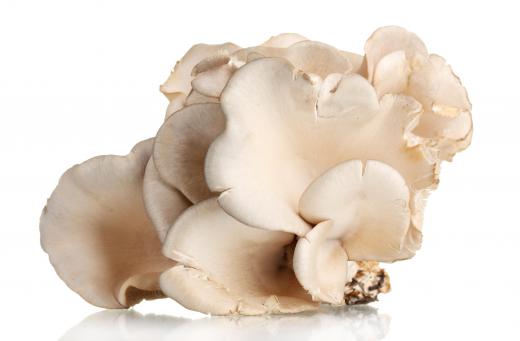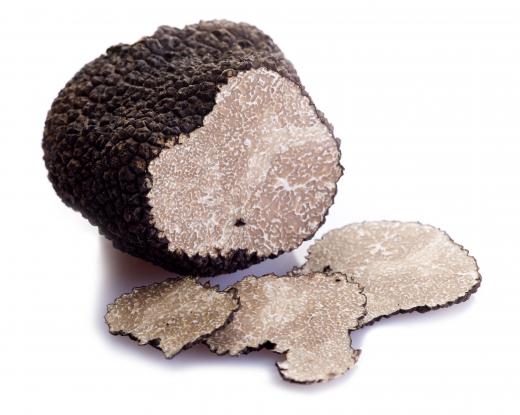What is Mycelium?
 Niki Foster
Niki Foster
The mycelium is the vegetative portion of a fungus, meaning that it is the portion that propagates through asexual reproduction. It consists of a web of hyphae, branching or forking thread-like structures. Depending upon the type of fungus, and how well developed it is, mycelia may be visible or microscopic. The mold that grows on decaying food, for example, is a visible form.
In addition to asexual reproduction, the mycelium is responsible for absorbing nutrients from the environment. It releases enzymes into the surrounding environment to break down the food source into a digestible form, then absorbs it. This process also helps dead plant material and other organic material to decompose. The material can also help renew the soil through this process, for example by decomposing contaminants such as pesticides. Some mycelia help plants absorb water and nutrients more efficiently, and others are also important food sources for invertebrates living in the soil.

Mycelia can also be extremely extensive. One notorious fungal colony in the forest of eastern Oregon once covered 2,400 acres (9.7 square km). It grew to such a size over about 2,200 years and killed the plant growth in the forest many times, each time leading to deeper layers of soil that could withstand the growth of larger and larger trees.
Sometimes, mycelium is used in farming or landscaping. In addition to its ability to replenish nutrients, some types of fungus form a symbiotic relationship, called a mycorrhiza, with the roots of a plant. The plant and the fungus help each other receive nutrients that they could not obtain on their own. Mycelia can also be used as an organic filter for soil or water in a process called mycofiltration, in which a mycelial mat keeps out harmful chemicals and microorganisms. They are also sometimes used to hold new soil in place on unpaved roads.

Some kinds of fungi use sexual reproduction as well as asexual reproduction. The sexually reproducing portion of a fungus arises from the mycelium and is called the sporocarp or fruiting body. The fruiting bodies of many different types of fungus are known as mushrooms or truffles, though there are some other types.
AS FEATURED ON:
AS FEATURED ON:
















Discussion Comments
@Fa5t3r - I bought a few orchids a while ago and they died on me because I didn't know how to care for them properly. Turns out it wasn't the orchid I was killing, it was the rhizopus mycelium in the soil that they needed to grow.
So fungi is definitely used in horticulture at the moment. And when you look at how much the economies of Asian countries (which eat far more mushrooms of various types than Western countries) are growing, I think there's going to be a bigger and bigger market for all kinds of fungus soon. And that means lots of research opportunities.
@clintflint - I think fungus often gets written off as just a sub-variety of plants, but they are their own thing and just like plants have so many different ways of growing, so do fungi.
It's a shame that you didn't stick to studying them though, because they are actually very useful in many ways. There's the obvious in that they are a good food, able to grow in places that other foods can't since they don't have the same need for sunlight (for example, many people could grow button mushrooms in their homes, even if they don't have room for green vegetables).
They have some amazing properties too, like the molds that are used in medicine. And, as it says in the article, they can contribute to the growth of other plants, so maybe one day someone will figure out how to use them more efficiently in agriculture.
I think more study of fungi and mycelium and so forth would be well worth it for everyone.
I'm really interested in fungus and was thinking about making it the focus of my science degree, but I was told that there isn't much call for that kind of research, so I switched to something else.
The wide variety among fungus is really amazing though. That story about the massive colony is only the tip of the iceberg, so to speak and there are plenty of other strange variants.
Post your comments